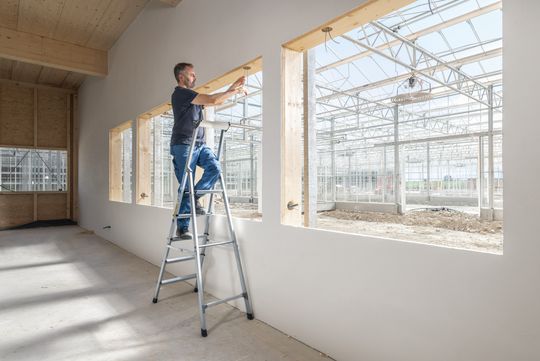The latest version of TRBS 2121-2 was published on 21 December 2018 in the German Ministerial Gazette. According to the document, employers are fundamentally obliged to ensure their employees' safety and perform risk assessments. It should be noted that a TRBS is not a statutory regulation; instead, it offers suggestions on how business owners can fulfil the requirements of the German Ordinance on Industrial Safety and Health (BetrSichV). Employers can also adopt other measures as long as they are able to provide their employees with the same level of safety and health protection. This means that compliance with a TRBS is always voluntary, whereas protecting the health and safety of employees is an obligation.
A matter of the intended use
TRBS 2121-2 differentiates between using ladders as a means of access and performing work from ladders. For the former case, the guidelines did not change considerably. A person may use a ladder to climb up to a place that is up to five metres higher, provided that the ladder extends at least one metre above the location to be accessed. Under special circumstances, the climb height may also be allowed to exceed five metres. Furthermore, ladders with rungs can continue to be used to access work areas at height.
There are, however, more changes when it comes to performing work from a ladder. In general, workers should only perform small-scale tasks from a ladder, such as levelling walls or changing light bulbs. If the standing height exceeds two metres, there are also limits placed on the amount of time a person can spend working from a ladder: the time spent working from a ladder must not exceed two hours per shift when the standing height is between two and five metres. Moreover, it is mandatory for someone working from a ladder to stand on a tread or platform in order to maintain secure footing. This means that ladders with rungs no longer fulfil the requirements except in special cases (such as work performed in narrow shafts). Such special cases have to be documented in a risk assessment.
Qualified support for a wide range of challenges faced in practice
"Safety should always be the top priority when using ladders and other access equipment," says ZARGES Product Manager Simone Harrer. "Therefore, we recommend that workers and businesses perform a risk assessment before they start using ladders." While single ladders with rungs are allowed to be used as a means of climbing up a higher place, stepladders or platform ladders should be chosen when a task involves working at height from a ladder. After a risk assessment has been performed, it is advisable to install a hook-on platform on step ladders with rungs, multipurpose ladders and other types of ladders.
"The changes made to TRBS 2121-2 are useful from a safety point of view, without replacing the current regulations in essence. Until now, ladders have been designed for light, low-risk tasks where using more elaborate equipment would be excessive," Harrer comments. "In future, we will continue to provide users with the right solutions for such applications. We also offer seminars and training courses that can help users fulfil the requirements of the relevant laws and regulations."
More information on TRBS 2121 Part 2 can be found at: https://www.zarges.com/de/trbs-2121-2/
You can find out more about the ZARGES Academy at: https://www.zarges.com/en/services/seminars-trainings/
The important points at a glance:
- Selecting the right equipment:
Before using a ladder, check whether a safer alternative (e.g. scaffold towers or aerial work platforms) can be used instead for the task at hand. If not, ensure that you choose the right kinds of ladders for the task (e.g. platform ladders). - Height difference must not exceed five metres:
Ladders may only be used in situations where the height difference is not more than five metres. The only exception is when the work location is accessed very rarely. - Do not use ladders with rungs:
Ladders with rungs are no longer to be used when working at height because the revised rules require workers to maintain secure footing (with both feet on a tread/platform). Exceptions may only be made in rare cases (for example for work in narrow shafts) and must be documented in writing in a risk assessment. - Time limit for tasks performed at heights of more than two metres:
A person is only allowed to work from a ladder tread or platform for extended periods of time when the working height is two metres or below. If the working height is between two and five metres, the amount of time spent working from a ladder must not exceed two hours per shift. Working from a ladder at heights of more than five metres is not permissible. - Professional inspection before use:
Before every use, a ladder should be visually inspected by a trained person for any signs of defects. A person can acquire the required knowledge through special training courses. Ladders subject to particularly high mechanical loads (for example on construction sites) need to undergo additional regular inspection. All ladder inspections must be recorded in writing. If a ladder has safety-related defects, it is not permitted to be used any more.
Press contact
Lewis Communications GmbH
Heike Malinowski
Johannstraße 1
40476 Düsseldorf, Germany
T. +49 211 8824 7643
E. zarges@teamlewis.com
